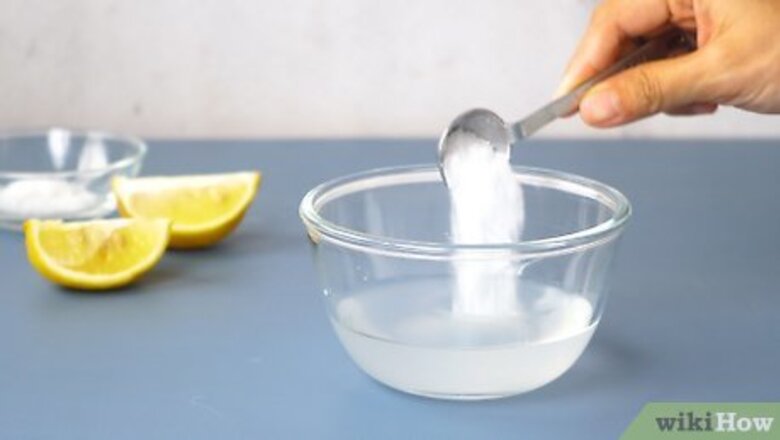
views
Note: If you suspect your penny has any possible value, do not clean it unless an appraiser recommends it. You may risk damaging it or lowering its value otherwise.
- Soak copper pennies in a mixture of white vinegar and salt for 10-15 minutes, then rinse. Alternatively, use ketchup for 5 minutes of Coke for 4-5 hours.
- Or, rub copper or zinc pennies with an eraser or a baking soda paste to remove grime and restore shine.
- Do not use acidic cleaners like vinegar on pennies from 1982 or after. These are mostly zinc instead of copper any may blacken when exposed to acid.
Cleaning Pennies with Vinegar & Salt
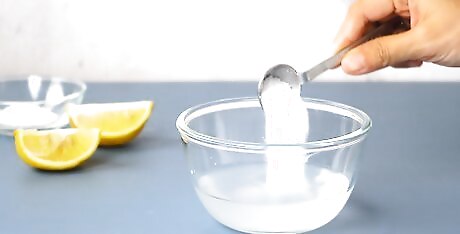
Mix 1 tsp (5 g) of salt and ¼ cup (59 mL) of white vinegar in a non-metal bowl. Stir the mixture to completely dissolve all of the salt. If you don’t have measuring cups on hand, just make sure to use enough vinegar to submerge all of the pennies you want to clean and dissolve as much salt as the vinegar can hold. If you plan to clean pennies with vinegar in bulk, use a bowl or container big enough to fit all of the pennies in a mostly flat, single layer. If you don't have vinegar, use lemon juice as an alternative. Copper oxide (the gunk on your pennies) dissolves in weak acids (like the acetic acid in vinegar or the citric acid in lemon juice). Even orange juice can be an effective penny cleaner! Warning: Do not use this method on pennies minted in or after 1982 that have scratches on them. Newer pennies are made of zinc coated in copper. Exposure to acid may cause the zinc to blacken.

Place your pennies in the vinegar or lemon juice for 10-15 minutes. Make sure they are not directly on top of each other so that the vinegar comes into contact with the entire surface of each coin. If they're extra dirty or if you're cleaning a lot of pennies at once, give them a few extra minutes for good measure. For especially grimy pennies, scrub them with a soft scrubber or toothbrush about halfway through their soak, then return them to the vinegar mixture.
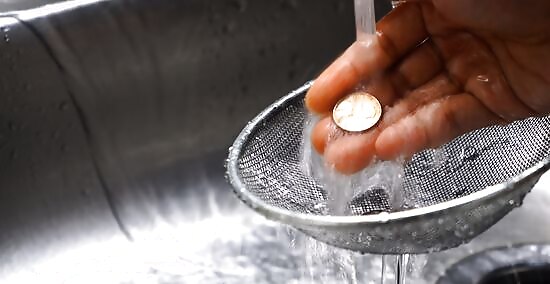
Take the pennies out and rinse them under running water. Make sure each coin gets thoroughly rinsed to remove all of the vinegar and salt, then lay them all out on a clean cloth or paper towel to dry. Let them air dry for about 5 minutes or so—they should be sparkling like new! If you don't rinse the pennies, a blue-green sheen will develop on them. This is the result of a chemical reaction—after the vinegar dissolves the layer of copper oxide, the copper atoms in the penny react with oxygen in the water and chlorine in the salt to form a new substance called malachite. For a fun science experiment, only rinse half of your pennies before letting them dry. Then, compare the colors and shininess that forms between the rinsed and unrinsed coins.
Cleaning Pennies with Ketchup
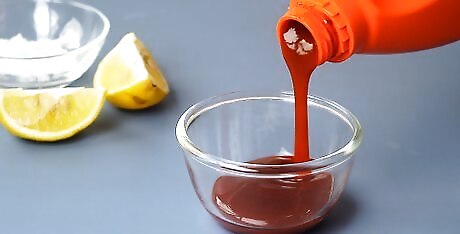
Put enough ketchup in a small cup to completely cover your pennies. Any brand of ketchup will do, but the more acidic it is, the more effective it will be at cleaning your coins. Take a look at the ingredients list—ketchups with high concentrations of vinegar or citric acid will work better than those with only tomato puree (tomatoes contain less acid than vinegar or citrus fruits). Keep in mind that you may be able to smell the ketchup on the penny when you are finished. Alternatively, try using tabasco sauce or hot sauce. Know that these might leave a slight orange tint on the penny (to fix this, rub the penny with a paste of baking soda and water, then rinse). Warning: Do not use this method on pennies minted in or after 1982 that have scratches on them. Newer pennies are made of zinc coated in copper. Exposure to acid may cause the zinc to blacken.
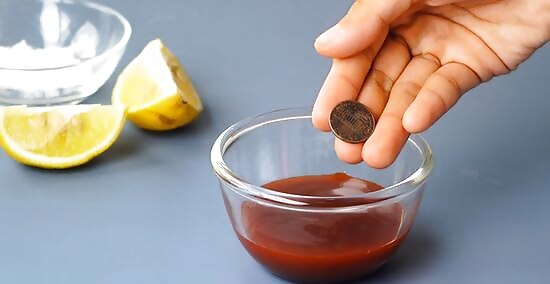
Submerge your pennies in the ketchup for about 5 minutes. Drop the penny in and swirl the cup carefully to completely cover it in ketchup. If the penny is extra dirty, give it a few extra minutes (the longer the penny is exposed to the acid, the cleaner it will become). If you have an old toothbrush handy, scrub the penny to work the ketchup into the little ridges part way through the soaking time.
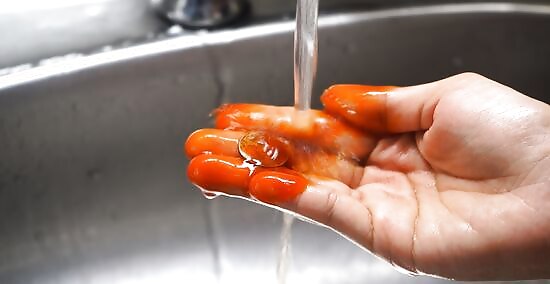
Rinse the penny clean with running water. Keep the penny in the cup and swirl in water from a faucet to rinse the ketchup away (just make sure not to slosh your penny out of the cup and lose it on accident). Keep flushing out the cup until all of the ketchup is gone. You’ll be left with a clean penny! If the pennies are clean but not shiny, mix a paste of baking soda and water and rub it into the pennies with your thumb or a brush. Then, rinse away the paste to reveal shiny copper.
Cleaning Pennies with Coca-Cola
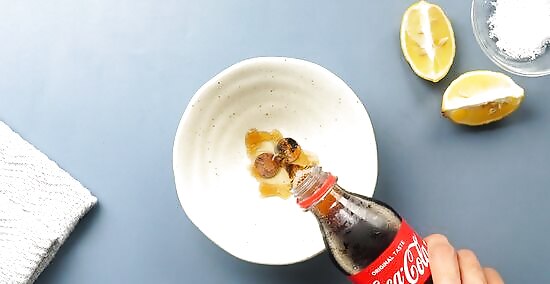
Lay your pennies in a single layer in a dish and cover them in Coca-Cola. Make sure no pennies are sitting on top of each other so that the soda can cover as much surface area as possible. Then, pour just enough Coke to cover all of the pennies completely (and feel free to enjoy the rest!). If you don’t have name-brand Coke on hand, use any dark soda as a substitute. Dark sodas, like Coke or Pepsi, contain phosphoric acid that can break down the oxidized copper on the surface of pennies, revealing the pure copper underneath. Dark soda is a surprisingly versatile cleaning liquid. You can even clean your toilet with Coke! Warning: Do not use this method on pennies minted in or after 1982 that have scratches on them. Newer pennies are made of zinc coated in copper. Exposure to acid may cause the zinc to blacken.

Let the pennies sit for about 4-5 hours or overnight. For the best results, flip the pennies over halfway through the process so the Coke can clean both sides equally. While this method works well, the downside is that it takes much longer than using cleaners like vinegar or ketchup.

Take the pennies out and rinse them clean with running water. If they’re not quite clean and shiny yet, submerge them in some fresh soda for another couple of hours for a deeper clean. Do not drink the soda that you used to clean the pennies with—it now contains some residual copper that can make you sick if you consume it.
Cleaning Pennies with Scouring Powder
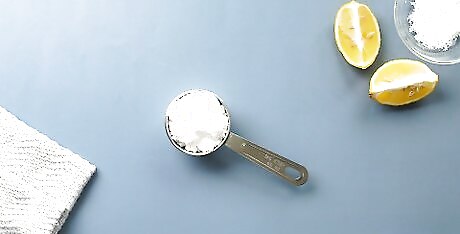
Purchase a scouring powder like Bar Keepers Friend or Bon Ami. These cleaning solutions work on all copper quickly, including pennies and copper-bottom cookware. If you don't have or can’t find these items, use baking soda as a less harsh alternative. Scouring powders and baking soda are great for restoring the shine and bright orange-y copper color to your pennies. This method is best for cleaning small amounts of pennies since you’ll have to tend to each coin individually. Warning: Test this method on a valueless penny first, especially if it’s minted in or after 1982 and contains zinc. Baking soda is typically harmless on zinc, but harsher powders may discolor the coin.
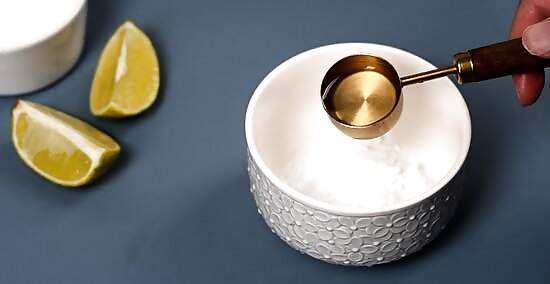
Make a paste with your powder in a small container. Pour about ¼ cup (68 g) of your scouring powder or baking soda into a bowl, then add water 1 tablespoon (15 mL) at a time until the mixture forms a thick paste.
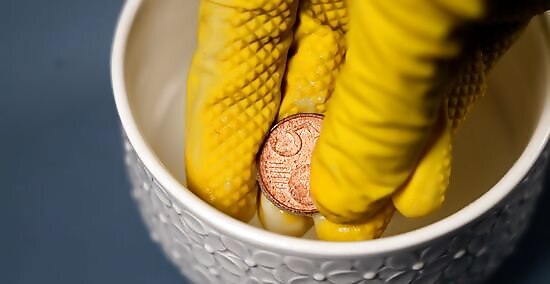
Wet your penny and rub the paste into it with your thumb and index finger. Get both sides of the coin wet, then gently rub your scouring powder or baking soda paste into the coin for 30-60 seconds. Wear cleaning gloves to protect your skin from the chemicals (and from the abrasion of rubbing pennies if you’re cleaning multiple coins this way). Alternatively, use an old, soft toothbrush in place of your fingers. Rubbing the penny for longer than 60 seconds will not make it cleaner. If you’re using Bon Ami or Bar Keepers Friend, it may also risk staining or damaging the coin.
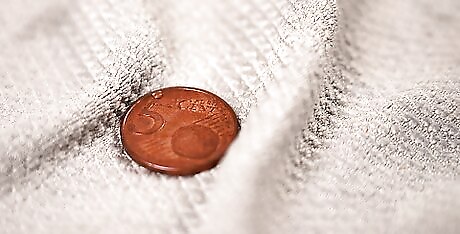
Rinse the penny clean and dry it with a microfiber cloth. After rubbing the coin, run it under the faucet to remove the remaining paste. For the best shine, wipe the penny dry with a clean microfiber or polishing cloth. Your pennies should now be shiny as new!
Cleaning Pennies with an Eraser

Grab a dirty penny and an eraser. Any eraser will work—use a block eraser, the eraser-end of a pencil, or even an electric eraser! This method is safe on any penny from any year. After 1982, copper became too expensive to justify using on a coin only worth 1 cent. Therefore, zinc (a much cheaper metal) started being used. Modern pennies are now 97.6% zinc and coated in a thin layer of copper.

Rub the penny with the eraser until it shines. This method uses friction to remove oxide marks and grime. Just erase the penny the same way you would erase a pencil mark on a piece of paper! If you’re handy or have many pennies to clean, some recommend attaching a pencil with an eraser to a drill and have it do the work for you.
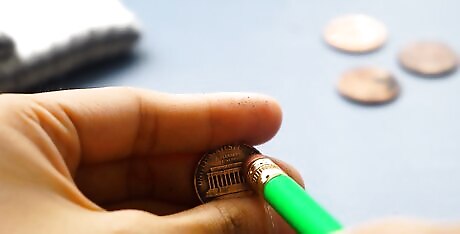
Flip the penny and erase the other side. Usually, it takes only about 10 seconds of erasing per side to make the penny look clean. The only downside to this is at the end, your hand may be tired, and you may be out a pencil or two! Other than that, this is a quick and easy path to shiny riches.
Using Dish Soap & Water
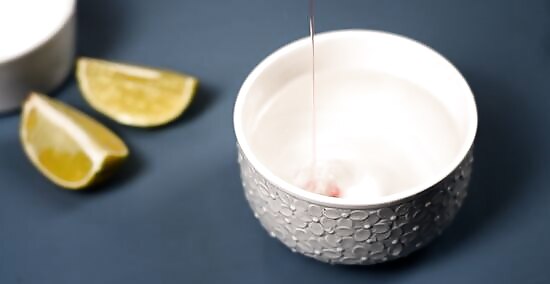
Mix clean water and a few drops of liquid dish soap in a small container. Use a mild soap, like Dawn, and stir the mixture so the soap is evenly mixed in. If you have hard water, use distilled water instead of the tap. This method is safe on any penny from any year.
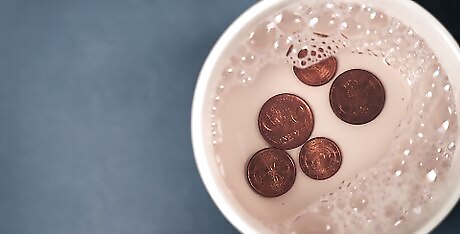
Let the pennies soak in the soapy water for several hours or overnight. If the coins are exceptionally dirty or grimy, use your fingers or a soft, fine brush to gently rub away loosened dirt and debris part way through the soaking time.

Rinse the pennies clean under running water. Make sure to rinse both sides of all your pennies to remove any remaining soap residue. If they’re clean but not very shiny, rub them with a baking soda paste and rinse them under clean water to restore their coppery shimmer.




















Comments
0 comment